2010 年 12 月 ACCA 考试 F6 真题
SUPPLEMENTARY INSTRUCTIONS
1. Calculations and workings need only be made to the nearest RMB.
2. All apportionments should be made to the nearest month.
3. All workings should be shown.
TAX RATES AND ALLOWANCES.
The following tax rates and allowances are to be used in answering the questions.
Enterprise income tax
Income tax for domestic and foreign enterprises
Rate
25%
Entrepreneurs who receive production or operation income derived from private
industrial or commercial enterprises
Level
Annual taxable income (RMB) Rate
Quick deduction factor (RMB)
1
2
3
4
5
5,000 or below
5,001-10,000
10,001-30,000
30,001-50,000
Over 50,000
Individual income tax
Employment income
5%
0
10%
250
20%
1,250
30%
4,250
35%
6,750
Taxable income on which employee bears the
Quick deduction
Grade
Rate(%)
tax/employer bears the tax (RMB)
factor (RMB)
1
2
3
4
5
6
7
500/475 or below
501 - 2,000/476 - 1,825
2,001 - 5,000/1,826 - 4,375
15,001 - 20,000/4,376 - 16,375
20,001 - 40,000/16,376 - 31,375
40,001 - 60,000/31,376 - 45,375
60,001 - 80,000/45,376 - 58,375
5
10
15
20
25
30
35
0
25
125
375
1,375
3,375
6,375
�
8
9
180,001 - 100,000/58,376 - 70,375
Over 100,000/70,376
40
45
10,375
15,375
For other income
each time below RMB 800
each time from RMB 801 to RMB 4,000
each time above RMB 4,000(with 20% allowance)
Income from services provided
for the part RMB 20,000 to RMB 50,000
for the part above RMB 50,000
Individual service income
Net of tax income
Before tax income
Quick deduction
Rate%
(RMB)
(RMB)
factor (RMB)
1 - 16,000
1 - 20,000
16,001 - 37,000
20,001 - 50,000
37,001 and above
50,001 or above
20
30
40
0
2,000
7,000
Business tax
Group
Rate
0%
20%
20%
30%
40%
Rate
transportation,construction,communication,culture and sports
3%
A
B
C
D
Group
hotels,restaurants,tourism,warehousing,advertising,transfer
of intangible property,sale of real estate
Group
Group
finance
recreation
Land appreciation tax The ratio of increased value against
the value of deductible items
for the
part
50% or below
5%
5%
5~20%
Rate
30%
�
for the
part
for the
part
for the
part
above 50% to 100%
above 100% to 200%
above 200%
For small-scale
taxpayers
For ordinary
for the sale or import of itemised
taxpayers
goods,processing,and repairing
for the sale or import of itemised goods
for transportation charges
Allowances
Funds for enterprises
Trade union fund
12% of total basic wages
Employee welfare fund
14% of total basic wages
Employee training fund
2·5% of total basic wages
40%
50%
60%
Rate
3%
17%
13%
17%
Donations
Enterprises
Individuals
up to 12% of the accounting profits
up to 30% of the taxable income
100% if donation made to certain funds approved by the
government
Entertainment expenses
For domestic and foreign
60% of the amount subject to a maximum of 0·5% of the
enterprises
sales/business income of the year.
ALL FIVE questions are compulsory and MUST be attempted
1 (a)Company A is a manufacturing joint venture enterprise,which was
established and started operations on 1 January 2009.The company‘s statement of
�
enterprise income tax(EIT)payable for the year 2009, as prepared by the accountant
of Company A is summarised below:
Turnover
Cost of goods sold
Gross profit
Note
RMB
200,000,000
(120,000,000)
-------------
80,000,000
Management and finance expenses
(1)
(35,000,000)
Investment income
(2)
330,000
Other loss:fixed assets written off
(3)
(200,000)
Taxable profits
Tax rate
Tax payable
Notes:
-------------
45,130,000
-------------
25%
11,282,500
(1)The management and finance expenses included the following:
Salaries and bonuses paid to staff (including RMB 100,000 as a
long service award for the general manager)
Entertaining expenses
Distribution of samples for promotion purposes
Donation to a qualified charity
Staff and workers benefits
Amortisation of approved intangible assets from self-developed
research
Penalty for late filing of Company A's tax statement
Stock loss provision
(2)The investment income comprises:
RMB
10,000,000
1,500,000
600,000
200,000
200,000
60,000
100,000
400,000
�
Gain on disposal of listed B-shares
Interest income on national debenture(gross)
Gain on disposal of national debenture(net)
RMB
200,000
30,000
100,000
(3)The original cost of the fixed assets written off was RMB 1,000,000,the
accumulated depreciation was RMB 800,000 and the accumulated tax allowances claimed
RMB 850,000.
Additional information:
In January 2009 Company A received the donation of a machine. The value added
tax (VAT) invoice for the machine showed that it had cost RMB 150,000 plus VAT
of RMB 20,000. No entry in respect of the donation of this machine has been recorded
in the accounting system of Company A.
Required:
(i)Briefly explain the enterprise income tax (EIT) treatment of:
- the donated machine; and
- each of the items listed in Notes 1 to 3. (15 marks)
(ii)Calculate the correct amount of taxable profits and the enterprise income
tax (EIT) payable by Company A for the year 2009. (7 marks)
(b)Company B is a resident enterprise,which was incorporated in the year
1990.The table below shows the taxable profits of Company B,as agreed by the tax
bureau,for the years 2002 to 2009 inclusive.
Year
2002
2003
2004
2005
2006
2007
2008
2009
Taxab
le
profits
(900,000)
00
(300,000)
00
00
00
(100,000)
00
100,0
100,0
100,0
200,0
850,0
(in
RMB)
Required:
(i)Briefly explain the tax treatment of losses,including the period for the
offset of losses;(2 marks)
�
(ii)State,giving reasons,how much enterprise income tax(EIT)will be payable
by Company B for each of the years 2008 and 2009. (4 marks)
(c)Define the term 'resident enterprise' for the purposes of enterprise income
tax(EIT)and state the differences in the scope of the assessment of EIT for resident
and non-resident enterprises. (7 marks)
(35 marks)
2(a)Mr Zhang,a Chinese citizen,is a University professor.He had the following
income for the month of January 2009:
(1)Monthly employment income of RMB 18,000 and a bonus for the year 2008 of
RMB 12,000.
(2)Income of RMB 18,000 for publishing a book on 6 January 2009.One of the
chapters of the book was published in a magazine as a four-day series commencing
on 19 January 2009 for which Mr Zhang received income of RMB 1,000 per day.
(3)A net gain of RMB 12,000 from trading in the A-shares market.
(4)Income of RMB 4,800 for giving four separate seminars for Enterprise X.
(5)A translation fee of RMB 5,200 from a media publisher.
(6)Received RMB 300,000 from the sale of the property(50 square metres)
that he had lived in for six years. Mr Zhang had acquired the property for RMB 180,000.
(7)Gross interest income of RMB 6,000 from a bank deposit.
(8)Received RMB 11,000 as insurance compensation.
Required:
Calculate the individual income tax(IIT)payable(if any)by Mr Zhang on each
of his items of income for the month of January 2009,clearly identifying any item
which is tax exempt. (10 marks)
(b)Mr Smith,who is a UK national,is employed by a UK construction company to
work in Shanghai on a project that will last for a period of 18 consecutive months.
Required:
(i)State,giving reasons,whether Mr Smith will be a resident taxpayer or a
non-resident taxpayer in the PRC and the scope of his individual income tax(IIT)
assessment;(2 marks)
�
(ii)List any THREE fringe benefits that can be provided to Mr Smith that will
not be subject to individual income tax(IIT)in China; (3 marks)
(iii)Briefly explain the requirements for the reporting and payment of the
individual income tax(IIT)due for Mr Smith if he is paid RMB 30,000 per month.
(5 marks)
(20 marks)
3(a)During the month of February 2009,Company C,a motor vehicle manufacturing
company,carried out the following transactions:
(1)Imported engines for production purposes for the equivalent of RMB 2,000,000
(including freight and insurance to the Chinese port).Company C paid a further
RMB 10,000 (including value added tax (VAT))to transport the engines from the
port to its warehouse.
(2)Purchased raw materials for RMB 800,000(excluding VAT)and received a
discount of 2% from the supplier for early payment. Company C paid transportation
costs of RMB 8,000(excluding VAT)and an insurance fee of RMB 5,000 in relation
to the delivery of the raw materials to its warehouse.
(3)Sold 200 of Model A motor vehicles at RMB 150,000 each(including VAT).
(4)Sold ten Model A motor vehicles to its own staff at their cost of RMB95,000
(excluding VAT)each.
(5)Company C is testing the performance of a new design of motor vehicle
(Model B).Five Model B motor vehicles were taken for self-use. The cost per unit
of Model B motor vehicles is RMB 130,000(excluding VAT);no market price has yet
been set for these vehicles.
Required:
Calculate the consumption tax(CT)and value added tax(VAT)payable by Company
C for each of the transactions(1)to(5)in the month of February 2009,clearly
identifying where no tax is payable.
Note:you should assume that:
(1)The tariff for all kinds of imported goods is 25%.
(2)Consumption tax(CT)is 10% for all types of motor vehicle.
�
(3)The deemed profit rate for the Model B motor vehicles is 8%. (11 marks)
(b)(i)State the value added tax(VAT)treatment of the disposal of self-used
fixed assets. Your answer should deal with assets which were bought both before and
after 1 January 2009; (2 marks)
(ii)State the value added tax(VAT)treatment of the disposal of used articles
(other than those used as fixed assets)and used cars; (2 marks)
(iii)The following transactions all occurred in the month of August 2009. All
figures are stated including value added tax(VAT).
(1)Company D sold a used machine for RMB 250,000,which had been bought in
January 2008 for RMB 200,000.
(2)Company E(a small-scale VAT taxpayer)sold a used machine for RMB
180,000,which had been bought in October 2005 for RMB 200,000.
(3)Company F sold a used machine for RMB 150,000,which had been bought in
January 2009 for RMB 120,000.
(4)Company G(a small-scale VAT taxpayer)sold a used machine for RMB
150,000,which had been bought in January 2009 for RMB 120,000.
(5)Company H sold a used car for RMB 150,000,which had been bought in January
2009 for RMB 120,000.
Required:
In the case of each of the sales(1)to(5),calculate the value added tax
(VAT)payable.
Note:unless otherwise stated all the companies are general VAT taxpayers.(5
marks)
(20 marks)
�
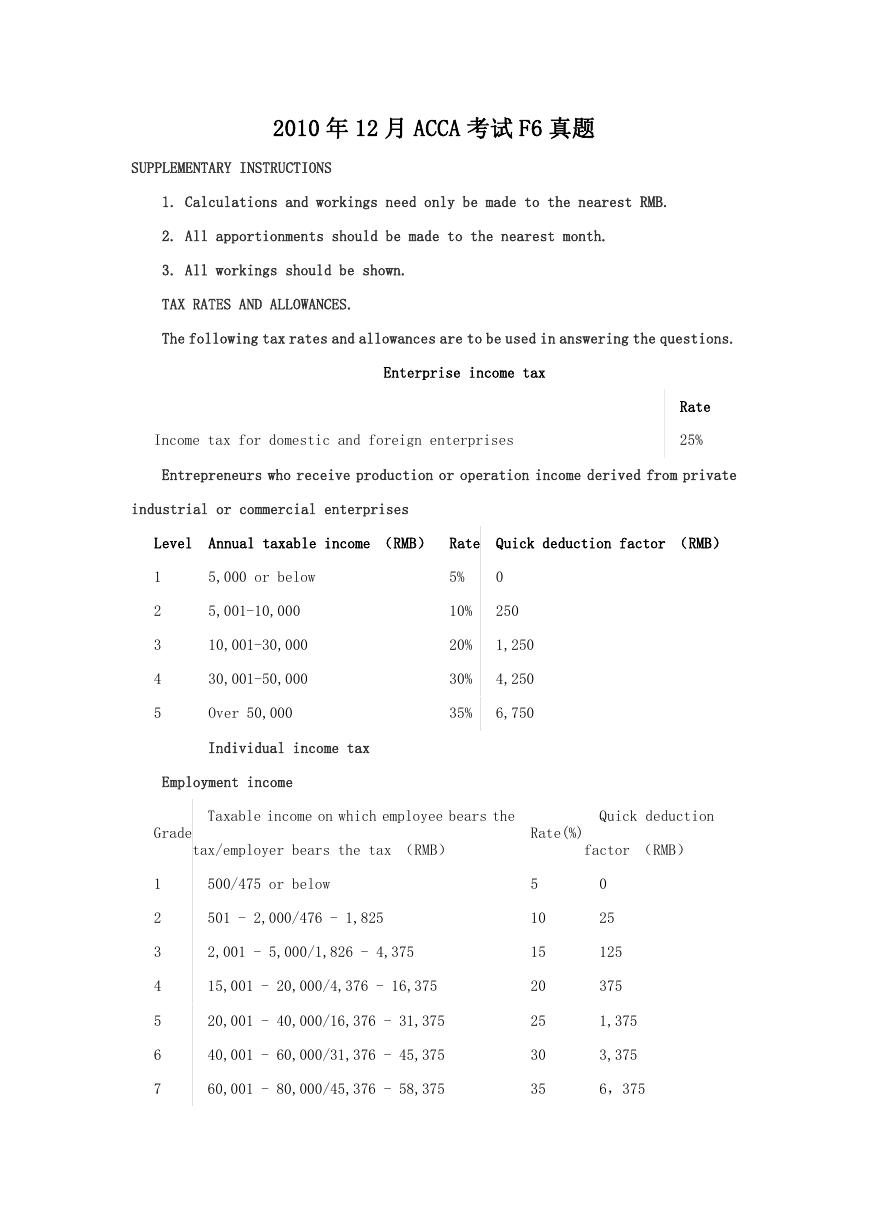
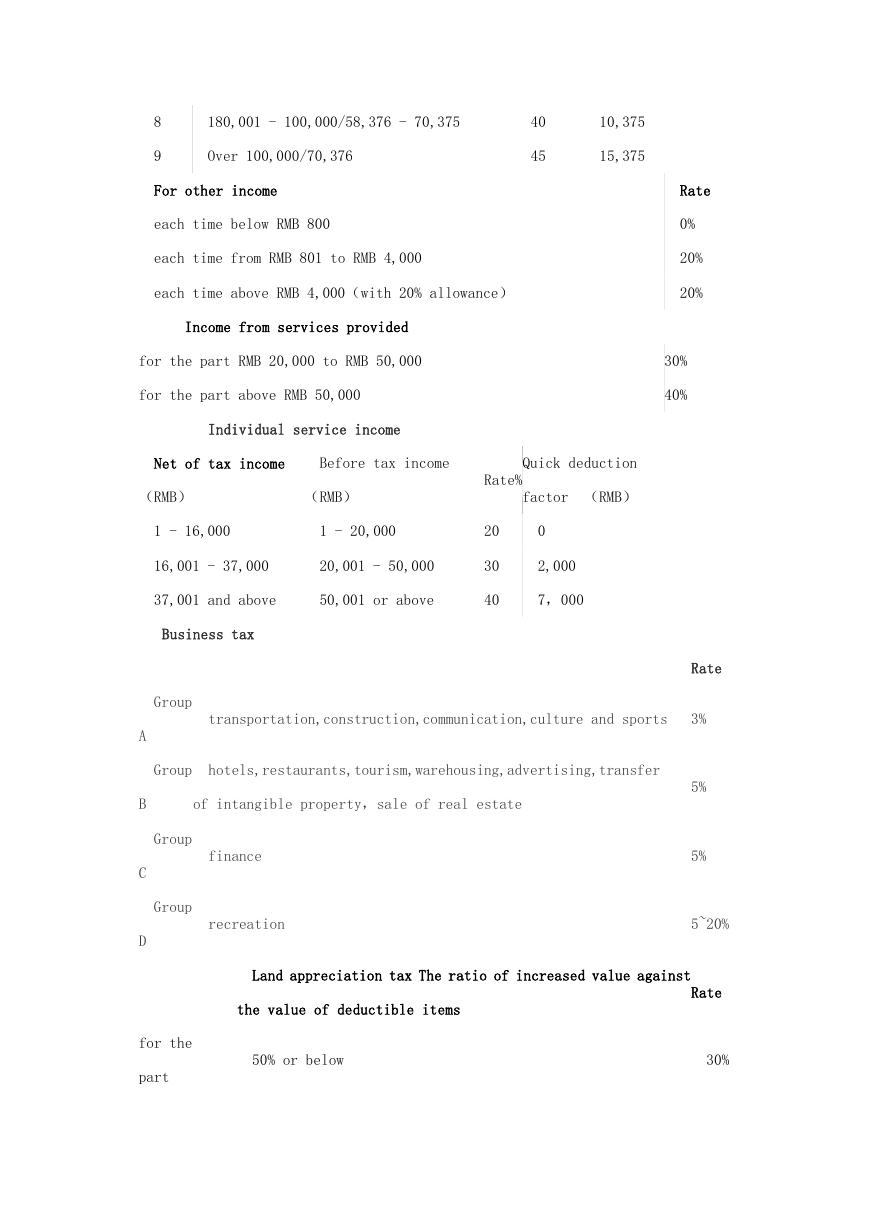
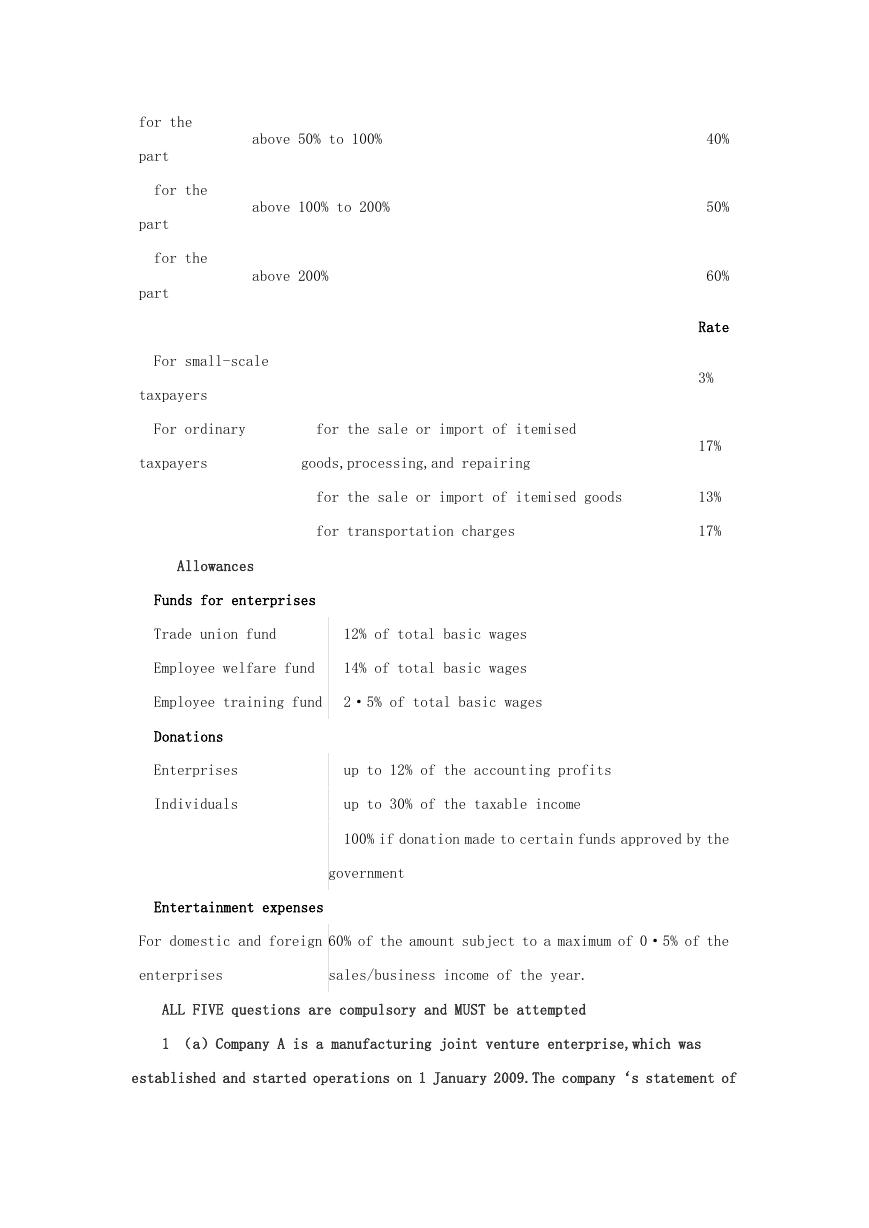
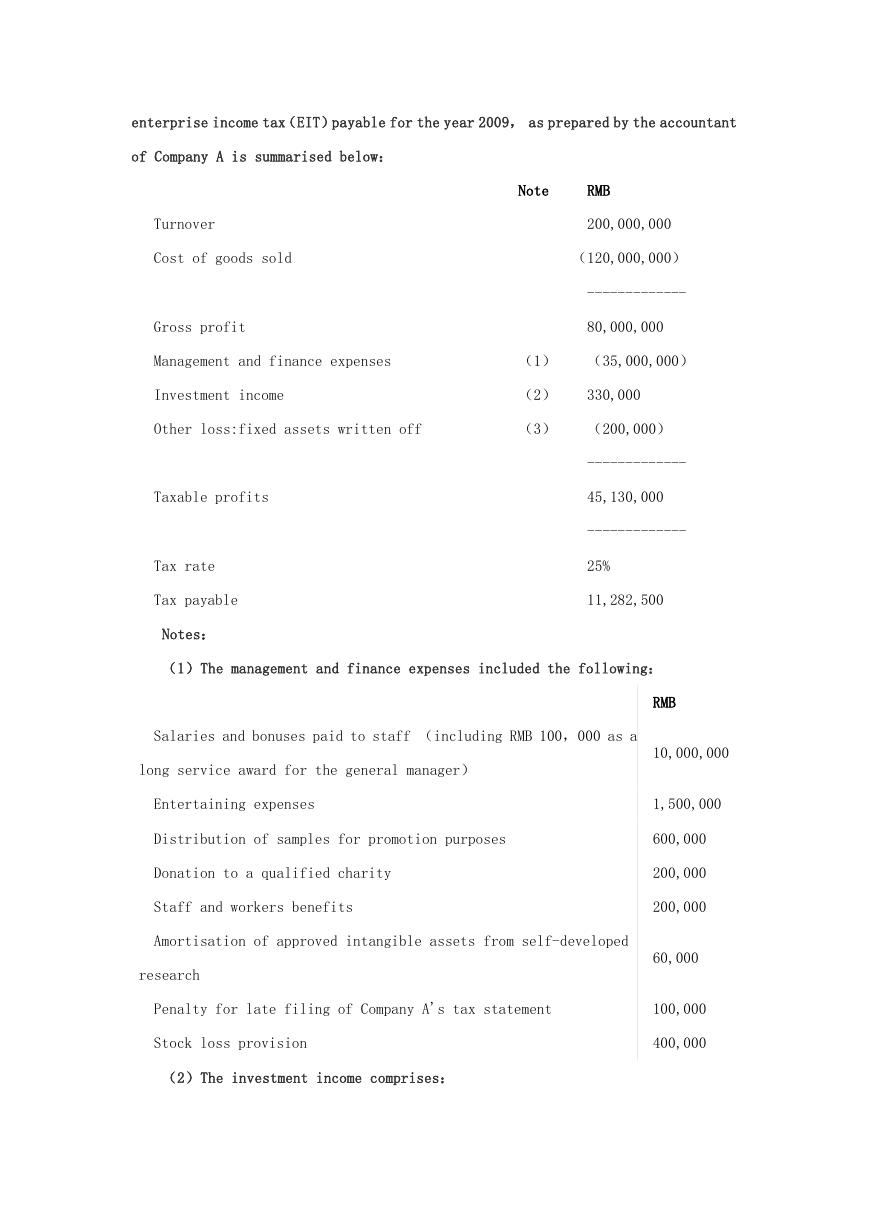
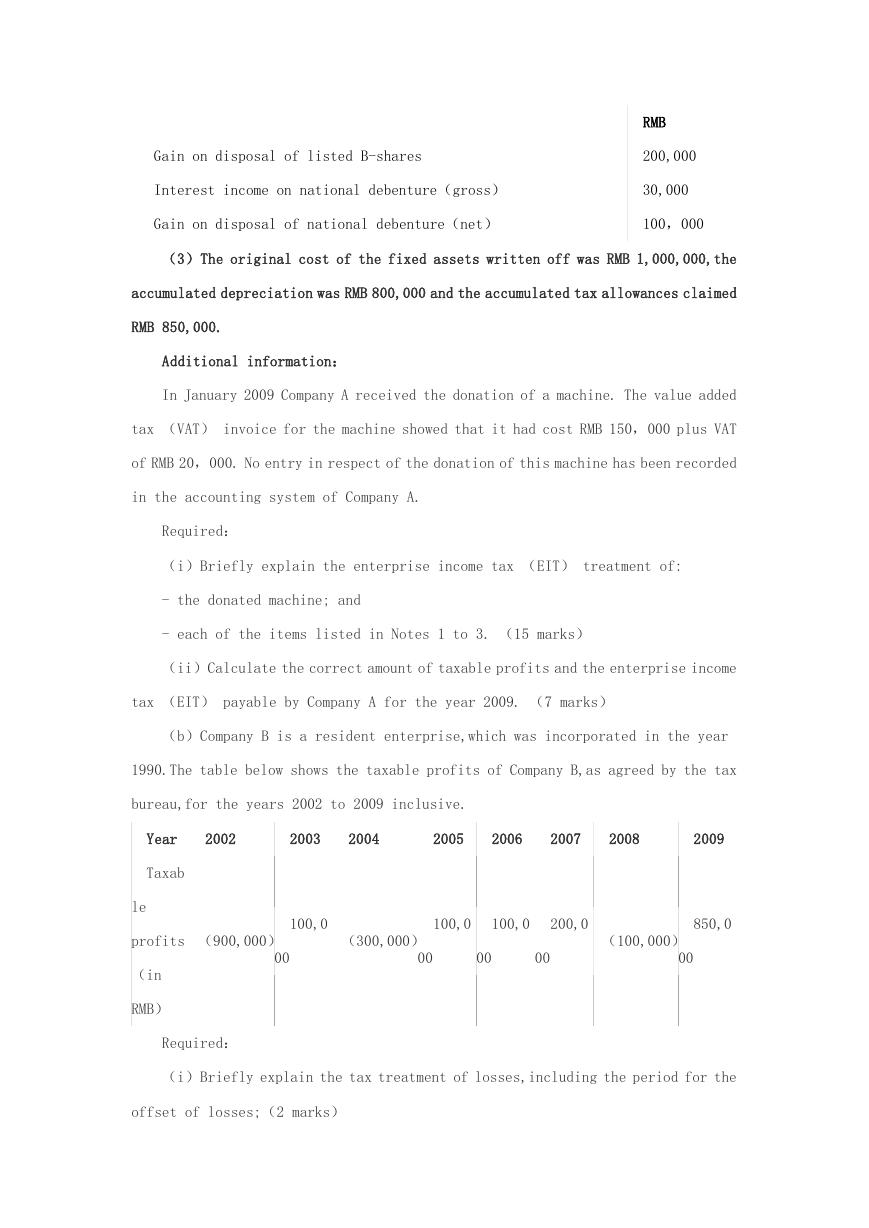
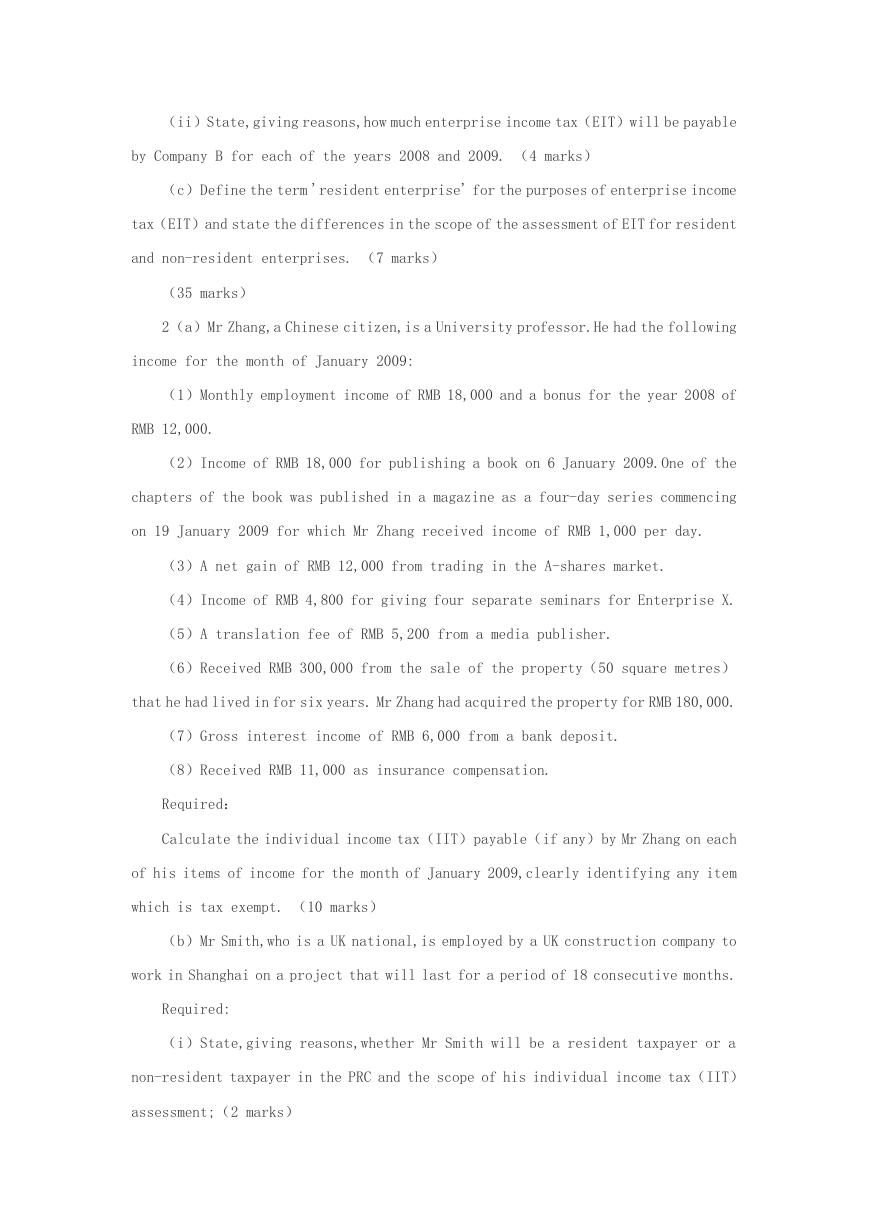
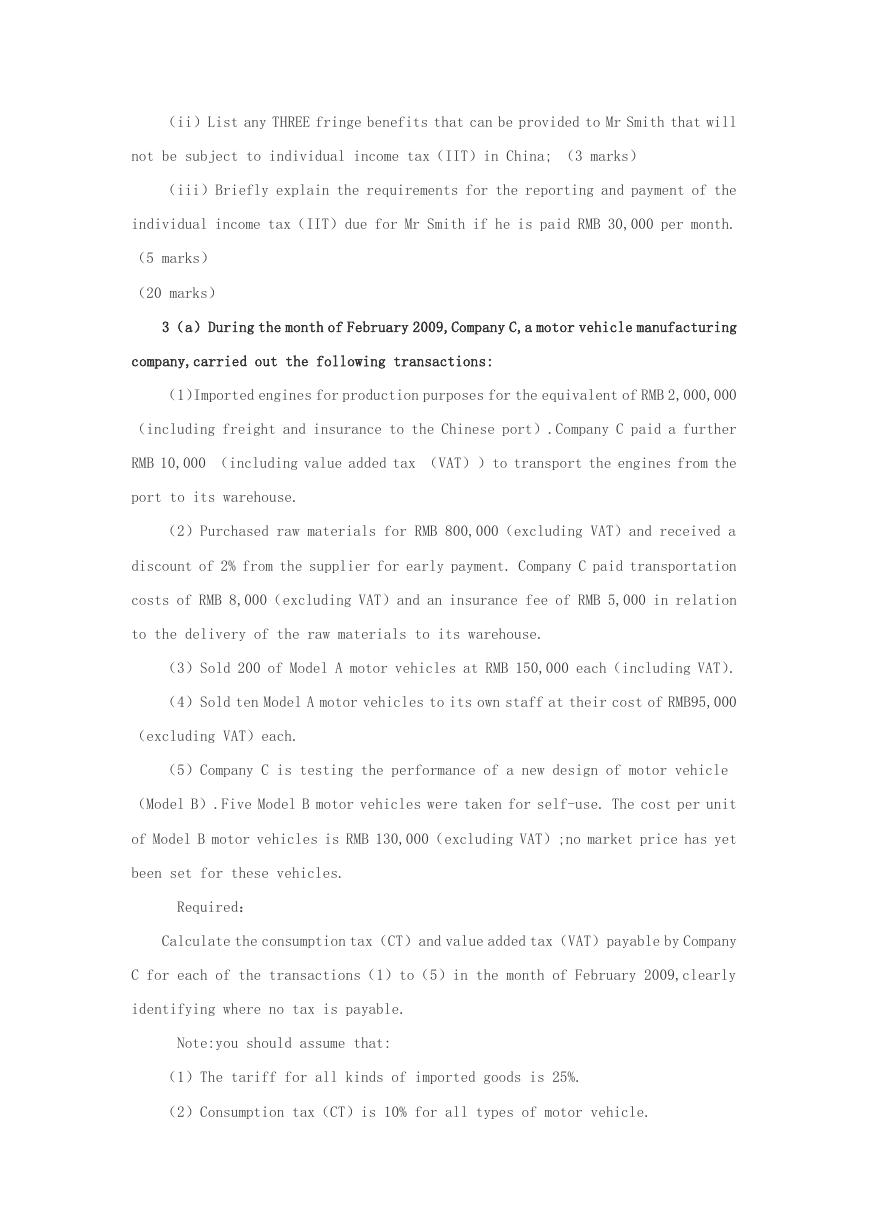
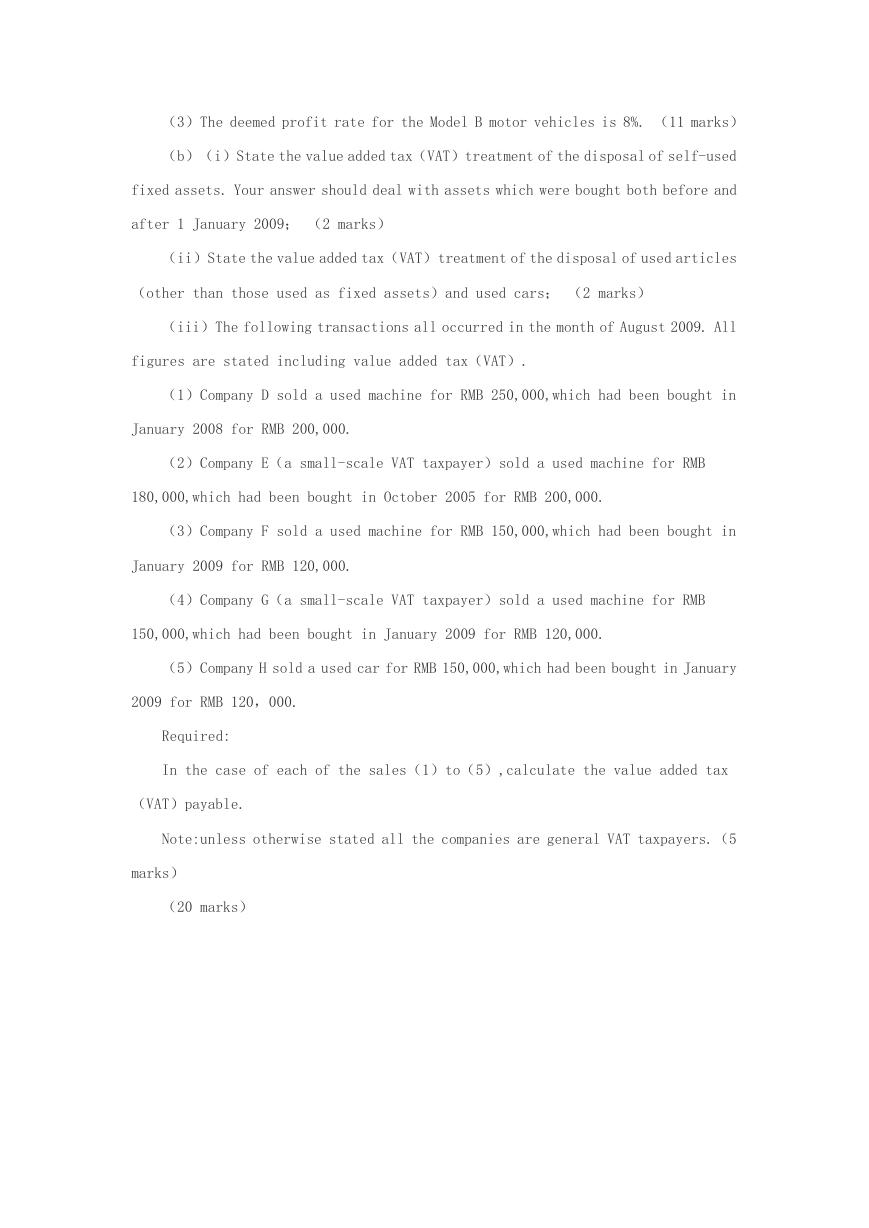








 2023年江西萍乡中考道德与法治真题及答案.doc
2023年江西萍乡中考道德与法治真题及答案.doc 2012年重庆南川中考生物真题及答案.doc
2012年重庆南川中考生物真题及答案.doc 2013年江西师范大学地理学综合及文艺理论基础考研真题.doc
2013年江西师范大学地理学综合及文艺理论基础考研真题.doc 2020年四川甘孜小升初语文真题及答案I卷.doc
2020年四川甘孜小升初语文真题及答案I卷.doc 2020年注册岩土工程师专业基础考试真题及答案.doc
2020年注册岩土工程师专业基础考试真题及答案.doc 2023-2024学年福建省厦门市九年级上学期数学月考试题及答案.doc
2023-2024学年福建省厦门市九年级上学期数学月考试题及答案.doc 2021-2022学年辽宁省沈阳市大东区九年级上学期语文期末试题及答案.doc
2021-2022学年辽宁省沈阳市大东区九年级上学期语文期末试题及答案.doc 2022-2023学年北京东城区初三第一学期物理期末试卷及答案.doc
2022-2023学年北京东城区初三第一学期物理期末试卷及答案.doc 2018上半年江西教师资格初中地理学科知识与教学能力真题及答案.doc
2018上半年江西教师资格初中地理学科知识与教学能力真题及答案.doc 2012年河北国家公务员申论考试真题及答案-省级.doc
2012年河北国家公务员申论考试真题及答案-省级.doc 2020-2021学年江苏省扬州市江都区邵樊片九年级上学期数学第一次质量检测试题及答案.doc
2020-2021学年江苏省扬州市江都区邵樊片九年级上学期数学第一次质量检测试题及答案.doc 2022下半年黑龙江教师资格证中学综合素质真题及答案.doc
2022下半年黑龙江教师资格证中学综合素质真题及答案.doc